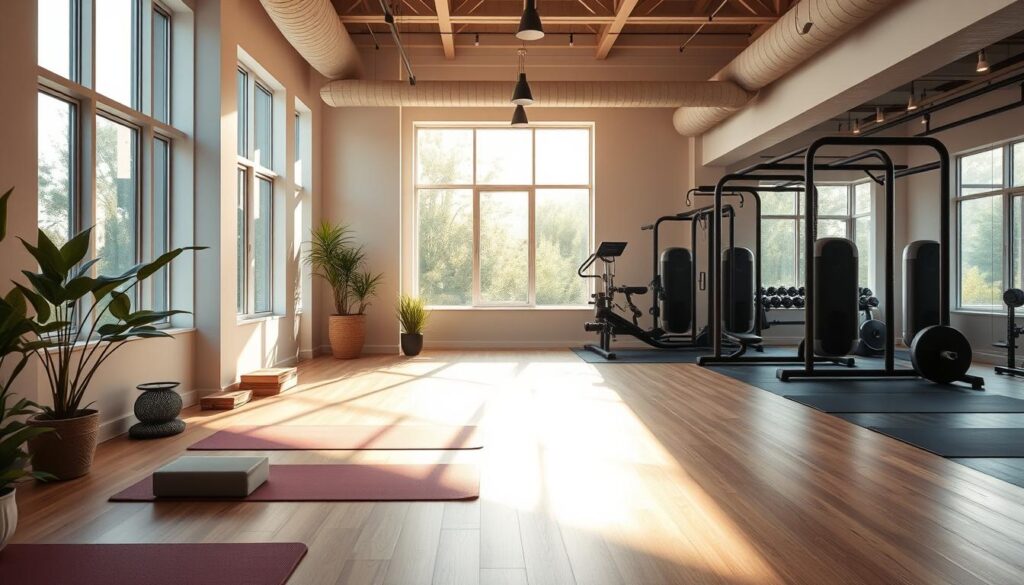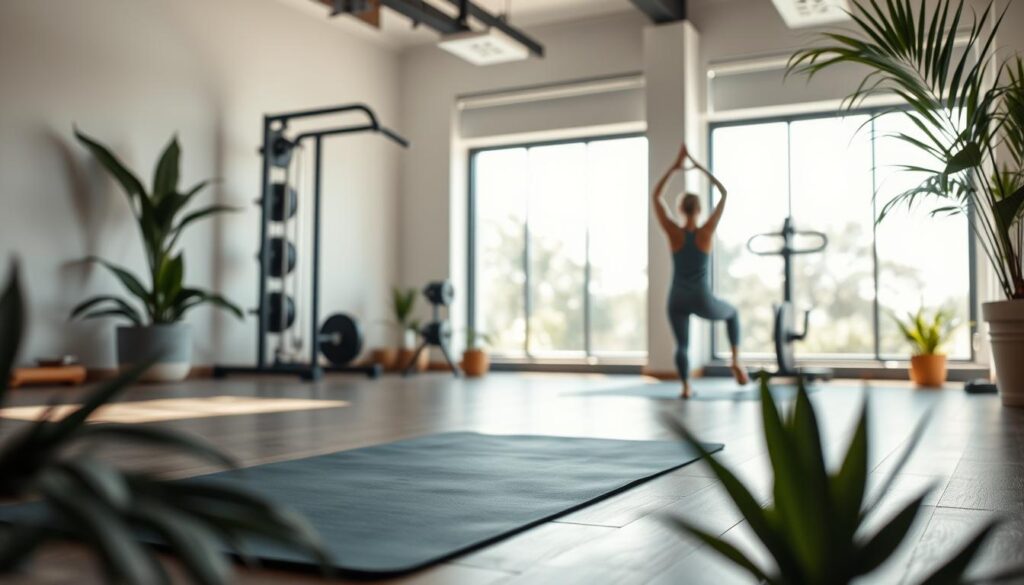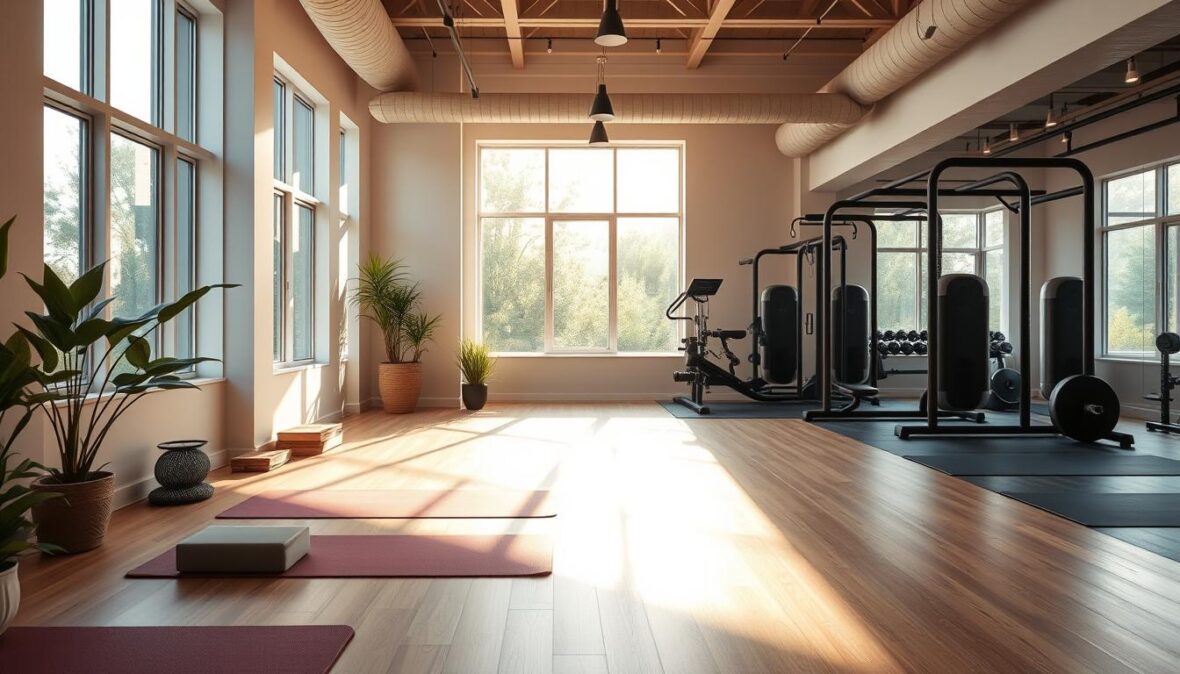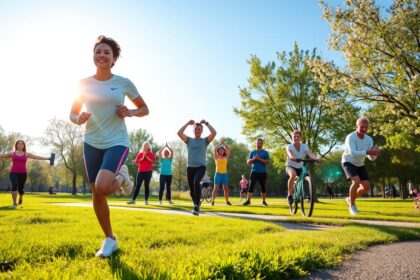In today’s fitness world, mixing yoga and strength training is becoming more popular. Many people find that combining yoga with their usual workouts boosts flexibility. It also helps with body awareness and lowers injury risks.
Adding yoga to your gym routine can improve your range of motion. It also helps activate more muscles. This makes your workouts more effective.
Yoga and gym workouts together create a full fitness plan. Yoga helps with recovery and improves focus. Balancing both can lead to more effective workouts. It makes reaching your fitness goals easier and more enjoyable.
Try combining yoga and gym sessions to change your workout routine. It’s a great way to enhance your fitness journey.

Benefits of Combining Yoga and Strength Training
Yoga and strength training together bring many benefits. They help you get stronger and feel better mentally. This mix is great for anyone who loves to stay fit.
Enhanced Flexibility and Range of Motion
Yoga makes your body more flexible. This helps you do strength training exercises better. It also lets you move more freely, which is key for lifting and working out.
Improved Strength and Endurance
Yoga boosts your muscle strength and endurance. It helps slow down muscle loss as you get older. Just 30 minutes of strength training, two times a week, can keep your muscles strong.
Injury Prevention and Recovery
Preventing injuries is important for keeping up with your workouts. Yoga helps by easing muscle tension. This means fewer injuries and quicker recovery times.
Creating an Effective Warm-Up with Yoga
Warming up before strength training is key. A yoga warm-up gets your body ready for what’s next. It uses poses to wake up big muscle groups gently.
Starting with basic yoga poses is a good idea. They help loosen up your body and get your spine moving. Simple actions like neck rolls can also help release tension.
Poses like the high lunge and tree pose work on your legs and core. Lifting your legs up stretches your hamstrings, feet, and calves. This makes you more flexible.
A good warm-up balances everything. Switching legs in certain poses keeps your hips flexible on both sides. Cat-cow stretches, done with your breath, improve your movement and focus.
As you start your practice, poses like downward facing dog stretch your legs more. Child’s pose is great for a gentle stretch of your hips and thighs. It also helps calm your mind.
The goddess pose is versatile, done standing or sitting. It helps relax you before moving into harder poses. How long you warm up depends on your age, the weather, and your needs.
On average, a yoga warm-up lasts about ten minutes. But seniors in cold weather might need up to 30 minutes. A good warm-up boosts blood flow and prepares you for a great yoga session.
Using Yoga as a Cool-Down After Strength Training
Adding yoga to your cool-down routine after strength training is key. It helps your body ease from intense activity to a calm state. This aids in muscle recovery and relaxation. Yoga also helps lower your heart rate and soothe tired muscles.
Importance of Cool-Downs
A good cool-down is crucial after working out. It helps slow down your heart rate, prevents dizziness, and reduces muscle soreness. Yoga makes this easier with its gentle movements and deep breathing. These calm your mind and body.
By doing yoga after your workout, you improve your recovery. You also find peace and tranquility.
Best Yoga Poses for Cooling Down
There are many yoga poses great for cooling down after strength training. They help with gentle stretching and relaxation. Here are some top picks:
- Pigeon Pose: This pose stretches the hips and glutes, easing tension and improving flexibility.
- Child’s Pose: A restful pose that stretches the back and quiets the mind, perfect for calming.
- Happy Baby Pose: This pose releases tension in the lower back and hips, promoting relaxation.
- Wide Leg Forward Fold: This pose stretches the hamstrings and lower back, aiding in muscle recovery.
It’s best to hold each pose for 45 to 60 seconds for the most benefits. Adding these poses to your routine helps your body recover. It also boosts flexibility and muscle recovery.
How to Manage Yoga and Workout Schedules
Adding yoga to your workout routine can boost your fitness and happiness. You can try the alternate day method or same-day workout splits. Both ways help you balance yoga and gym time, making sure you get the best of both.
Alternate Day Strategy
The alternate day plan means you alternate between gym days and yoga days. Here’s what a weekly schedule might look like:
| Day | Activity |
|---|---|
| Monday | Strength Training |
| Tuesday | Yoga Class |
| Wednesday | Strength Training |
| Thursday | Yoga Class |
| Friday | Strength Training |
| Saturday | Yoga – Therapeutic Session |
| Sunday | Rest or Light Yoga |
This schedule gives you enough time to recover. It helps you get the most out of both activities without getting too tired.
Same Day Workout Splits
If you’re short on time, try doing yoga in the morning and gym workouts in the afternoon. Yoga in the morning gets your body ready for the day. Then, your gym workout can be more intense.
- Morning: 30-minute yoga flow focusing on flexibility and breathwork.
- Afternoon: 45-minute strength training session, emphasizing major muscle groups.
This mix keeps your energy up and helps you recover well. It makes you better at both yoga and gym workouts.

Building Strength with Yoga Poses
Yoga poses are a special way to build strength using your own body weight. Mixing yoga with strength training boosts muscle activation and physical stability. The Plank Pose, for example, works many muscles like the abs and back.
This pose is great for building core strength and works the shoulders and legs too. It’s a key pose for any workout routine.
The Chair Pose targets the legs and glutes. It requires focus and improves balance and stability. Warrior I Pose strengthens the lower body and improves core stability, key for strength training.
Dolphin Pose strengthens the shoulders and back, perfect for upper body strength. The Bridge Pose boosts hip flexibility and strengthens the glutes and hamstrings. Boat Pose and Hovering Tabletop work the core, focusing on deep abdominal muscles.
Adding poses like Side Plank and Chaturanga Dandasana to your routine can boost strength. Each pose targets specific muscles and improves overall fitness. Power Yoga or Ashtanga can be a solid base for combining yoga with strength training.
Sample Combined Yoga and Gym Workout Routine
This workout routine combines yoga, strength training, and cardio. It boosts fitness and adds mindfulness from yoga. A good schedule includes activities for better performance and recovery.
Morning Yoga Flow
The morning yoga flow wakes you up. It focuses on poses that improve flexibility and energize the body. A typical session lasts 15-20 minutes and includes:
- Sun Salutations
- Downward Dog
- Warrior II
- Tree Pose
- Cat-Cow Stretch
This routine boosts energy and sets a positive tone for the day. It’s easy to adjust for beginners or those needing modifications.
Evening Strength Training
Evening workouts focus on strength training after yoga. Aim for 20-30 minutes of exercises targeting major muscles. Here’s an example routine:
| Exercise | Sets | Reps |
|---|---|---|
| Squats | 3 | 10-12 |
| Bench Press | 3 | 8-10 |
| Deadlifts | 3 | 8-10 |
| Rows | 3 | 10-12 |
| Plank | 3 | 30-60 sec |
These exercises improve bone density, important for women near menopause. The morning yoga boosts mobility, making lifting better. Rest days are key, aiming for 3-4 workouts a week for best results.
Choosing the Right Type of Yoga for Your Goals
Choosing the right yoga can really change your fitness routine and how you feel. There are over 20 different yoga styles, each with its own purpose. Restorative yoga is great for those who want to relax and recharge. It uses gentle movements and stillness to help you slow down.
If you want to get more flexible and strong, Hatha or Vinyasa yoga might be for you. Hatha yoga is good for beginners, focusing on basic poses and relaxation. Vinyasa yoga, on the other hand, is all about flowing movements that build strength and endurance.
Power yoga is for those who want a workout that’s both challenging and fun. It combines strength and flexibility training, helping you burn calories and build muscle. For a more relaxing experience, try Yin yoga or Anusara, which focus on meditative poses.
When picking a yoga style, think about your fitness level and what you want to achieve. Kundalini yoga offers a mix of physical practice and spiritual insights. Couples yoga is a fun way to bond with your partner through shared poses.
Prenatal yoga is special for pregnant women, helping them stay strong and flexible during pregnancy. It’s designed to support both the body and mind of expectant mothers.
Ultimately, finding the right yoga is about trying different styles and teachers. Listen to what you want and need, and you’ll find a practice that makes you feel good both physically and mentally.
| Type of Yoga | Focus/Benefits |
|---|---|
| Restorative Yoga | Restores energy; gentle practice for stress relief |
| Hatha Yoga | Strengthening; relaxation and flexibility |
| Vinyasa Yoga | Dynamic flow; builds strength and endurance |
| Power Yoga | Athletic focus; burns calories while increasing strength |
| Yin Yoga | Deep stretching; meditative floor-based practice |
| Kundalini Yoga | Spiritual and philosophical; enhances self-awareness |
| Prenatal Yoga | Supports pregnancy; improves strength and relaxation |
| Couples Yoga | Builds trust; poses done with a partner |
Preventing Overtraining: Balancing Yoga and Gym
It’s important to find a balance between yoga and gym workouts. This balance helps you perform better and stay healthy. Knowing the signs of overtraining is key to avoiding it and keeping your progress steady.
Recognizing Signs of Overtraining
Overtraining can show up in many ways. You might feel muscle soreness that lasts too long, get tired easily, or see your performance drop. Here are some signs to watch for:
- Extended muscle soreness lasting beyond 24 hours
- Frequent injuries that do not heal properly
- Increased resting heart ratehttps://bodygoalshub.com/essential-tips-for-preparing-for-your-physical-fitness-test-success/
- Exercise-induced insomnia
- Low energy levels throughout the day
Pay close attention to these signs, even more so when you’re working out a lot. Taking rest days, like going for a walk or doing gentle yoga, helps your body recover.
Setting Realistic Exercise Goals
Setting goals that are within reach is crucial when you’re doing both yoga and gym workouts. This means:
- Knowing your own fitness level
- Getting enough rest to recover
- Adjusting how hard you work out based on how your body feels
Going too hard can slow you down and even cause injuries like shin splints. By setting goals you can reach and taking breaks, you can keep your fitness journey going strong.

Balance is the secret to successfully mixing yoga and gym workouts. Planning carefully helps you get stronger without overdoing it and risking injury or burnout.
| Signs of Overtraining | Suggested Recovery Approaches |
|---|---|
| Persistent muscle soreness | Gentle yoga sessions |
| Fatigue and low energy | Rest days with light activity |
| Decline in performance | Review workout intensity and duration |
| Increased injuries | Incorporate active recovery techniques |
| Sleep disturbances | Practice restorative yoga or meditation |
Integrating Yoga for Better Body Awareness
Yoga is a great way to improve body awareness and mindfulness. It combines physical poses, breathing, and meditation. This helps people understand their bodies better.
Regular yoga practice boosts flexibility and strength. It also clears the mind and stabilizes emotions. Techniques like Ujjayi breath and 4-7-8 breathing make you more aware of your body’s limits.
Poses like Tree Pose and Seated Forward Bend focus the mind. They help spot tension or imbalance. With time, yoga can also improve your posture, enhancing fitness and performance.
Yoga’s slow movements deepen your connection with your body. It can even help with back pain or migraines. This heightened awareness lets you listen to your body and respond wisely.
Yoga helps set intentions for personal growth. Keeping a journal tracks your progress. This supports your wellness goals and emotional balance, making fitness more holistic.
Conclusion
Combining yoga and gym workouts can really boost your fitness journey. It creates a balanced routine that mixes strength and flexibility. Yoga not only helps with physical health, like increasing flexibility and strength, but also improves mental well-being by lowering stress and anxiety.
As more people see the benefits, mixing yoga with strength training is getting more popular. This approach helps you perform better and connect your mind and body more deeply. It leads to better health and lets you adjust your workout schedule to meet your needs and goals.
The science backs up yoga’s benefits, showing it’s key to a complete fitness plan. Everyone’s fitness journey is different, and finding the right mix of activities is crucial for ongoing improvement and wellness. By using yoga with traditional strength training, you set yourself up for a more rewarding and empowered fitness experience.



